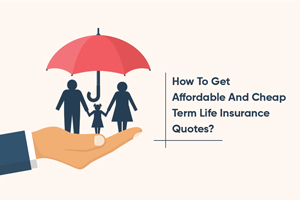The Secrets to Getting Accurate and Affordable Life Insurance Quotes
Life insurance is an essential financial tool, offering protection and peace of mind to families and individuals alike.

Life insurance is an essential financial tool, offering protection and peace of mind to families and individuals alike. With numerous policies available, understanding the different types and how their rates compare is crucial for making informed decisions. In this guide, we will explore various life insurance policies, their costs, and factors influencing these rates, such as age, health, and coverage amount.
Types of Life Insurance Policies
1. Term Life Insurance
Term life insurance is one of the most straightforward and affordable life insurance options. It provides coverage for a specific term, typically ranging from 10 to 30 years. If the insured dies within this term, the beneficiary receives a payout. If the term expires and the insured is still alive, no benefits are paid.
Rates for term life insurance are generally lower than other types, making it an attractive option for affordable life insurance. Premiums depend on factors such as age, health, and the term length. Younger, healthier individuals often enjoy lower premiums. Using a life insurance calculator can help estimate the cost based on these variables.
2. Whole Life Insurance
Whole life insurance offers coverage for the insured's entire life, as long as premiums are paid. In addition to providing a death benefit, this policy accumulates cash value over time. This cash value can be borrowed against or used to pay premiums.
Rates for whole life insurance are higher compared to term life due to its lifelong coverage and cash value component. Premiums are generally fixed but can vary based on age, health, and the policy’s face value. Life insurance quotes for whole life insurance typically reflect these higher costs.
3. Universal Life Insurance
Universal life insurance combines a death benefit with a flexible savings component. Policyholders can adjust their premiums and death benefits, and the policy accumulates cash value based on a variable interest rate.
Rates for universal life insurance can vary significantly due to its flexible nature. Premiums might be higher than term life but more affordable than whole life, depending on the chosen coverage and cash value growth. Life insurance comparison tools can help in evaluating different universal life policies.
4. Guaranteed Issue Life Insurance
Guaranteed issue life insurance is designed for individuals who might have difficulty obtaining coverage due to health issues. There are no medical exams required, and acceptance is guaranteed.
Rates for guaranteed issue life insurance are generally higher due to the increased risk to the insurer. This type of policy is ideal for those seeking life insurance for seniors or individuals with existing health conditions.
5. No Medical Exam Life Insurance
No medical exam life insurance allows applicants to bypass medical underwriting. Instead, rates are based on factors like age and health history, often resulting in higher premiums compared to traditional policies.
This option is suitable for those needing life insurance for diabetics, life insurance for smokers, or other specific health-related coverage. The convenience of avoiding medical exams comes at a cost, reflected in higher life insurance rates.
6. Final Expense Insurance
Final expense insurance covers funeral and burial costs. This type of policy typically offers a lower coverage amount and is often available without a medical exam.
Rates for final expense insurance are generally lower but can vary based on the coverage amount and the insured's age. It provides an affordable option for those looking to cover end-of-life expenses.
7. Joint Life Insurance
Joint life insurance covers two individuals, usually a couple, with a single policy. Benefits are paid out upon the death of the first insured or the last, depending on the policy type.
Rates for joint life insurance can be more cost-effective than purchasing separate policies. However, the exact cost depends on the ages, health conditions, and coverage amounts of both individuals.
Factors Influencing Life Insurance Rates
Several factors influence life insurance rates, including:
- Age: Younger individuals generally pay lower premiums as they are considered lower risk.
- Health: Health conditions such as diabetes or smoking can increase premiums. Life insurance for high-risk individuals may be more costly.
- Coverage Amount: Higher coverage amounts result in higher premiums.
- Policy Type: Term life insurance is often more affordable compared to whole or universal life insurance.
Comparing Life Insurance Rates
When looking for the best life insurance, it's essential to compare different policies and providers. Using tools like life insurance quotes and life insurance calculators can help estimate costs and find the most suitable option for your needs.
For specific needs, such as life insurance for business owners, life insurance for families, or life insurance for new parents, tailored policies are available. Additionally, life insurance for veterans, life insurance for teachers, and life insurance for high net worth individuals offer specialized coverage options.
Understanding the various types of life insurance policies and their rates is key to selecting the right coverage. Whether you're seeking affordable life insurance, life insurance for seniors, or life insurance for children, comparing quotes and using a life insurance calculator can help you make informed decisions. By considering factors such as age, health, and coverage needs, you can find a policy that provides the best value and protection for you and your loved ones.
For personalized advice and assistance, consider reaching out to life insurance agents near me. They can help guide you through the selection process and ensure you find the best life insurance to fit your unique needs.
How to Shop for Life Insurance A Comprehensive Guide
Navigating the world of life insurance can seem overwhelming, but with a bit of guidance, you can find the best policy tailored to your needs. Whether you're in Pittsburgh, San Antonio, Baltimore, Columbus, or Portland, understanding how to shop for life insurance and compare quotes is essential for securing the right coverage at the best rates.
1. Understand Your Life Insurance Needs
Before diving into life insurance quotes and policies, assess your personal needs. Consider factors like:
- Family structure: Are you protecting a spouse, children, or dependents?
- Financial responsibilities: Do you have a mortgage, debts, or other financial obligations?
- Long-term goals: Are you planning for retirement or estate planning?
Identifying these needs will guide you in choosing between options like term life insurance, whole life insurance, or universal life insurance.
2. Explore Different Types of Life Insurance
Term life insurance provides coverage for a specific period, such as 10, 20, or 30 years. It's often the most affordable type and ideal for temporary needs, like raising children or paying off a mortgage.
Whole life insurance offers coverage for your entire life, along with a cash value component that grows over time. It's a good choice for those seeking lifelong protection and a savings component.
Universal life insurance combines flexible premiums with a cash value account that earns interest. It's suitable for those who want adjustable coverage and premium options.
For specialized needs, you might consider:
- Guaranteed issue life insurance: No medical exam required, but typically comes with higher premiums and lower coverage amounts.
- No medical exam life insurance: Faster approval but may have higher rates.
- Final expense insurance: Covers funeral costs and other final expenses.
3. Gather and Compare Quotes
Start by obtaining life insurance quotes from multiple providers. Many websites offer free life insurance calculators that help estimate your needs and compare quotes. Look for:
- Affordability: Ensure the premiums fit within your budget.
- Coverage amount: Match the coverage with your financial obligations and goals.
- Policy terms: Review the duration, renewal options, and any exclusions.
4. Evaluate the Best Life Insurance Providers
Research the best life insurance companies based on:
- Premium rates: Compare rates for similar coverage amounts and policy types.
- Customer service: Check reviews and ratings for customer support and claims processing.
- Financial stability: Look into the company's financial strength and reliability.
5. Consider Specialized Coverage Options
Depending on your situation, you might need:
- Life insurance for seniors: Tailored to older individuals, often with higher premiums.
- Life insurance for children: Provides coverage for minor dependents, usually to cover future insurability.
- Affordable life insurance: Budget-friendly options for those seeking basic coverage.
- Life insurance for diabetics or smokers: Specialized policies for high-risk individuals.
- Life insurance for business owners or self-employed: Protects business interests and income.
6. Assess Additional Features and Benefits
Evaluate if the policy includes:
- Living benefits: Allows access to benefits if you face a critical illness or other major health issues.
- Joint life insurance: Covers two people, typically at a reduced rate.
- Coverage for specific professions: Policies tailored for teachers, healthcare workers, police officers, firefighters, construction workers, athletes, or entertainers.
7. Consult with an Agent
Working with a life insurance agent near me can provide personalized assistance. They can help you navigate the options, explain complex terms, and find policies suited to your unique needs.
8. Finalize Your Policy
Once you've compared options and selected a policy, review the terms carefully before signing. Ensure all details align with your initial requirements and that you understand the policy's benefits and limitations.
Choosing the right life insurance involves understanding your needs, comparing different types of policies, and evaluating providers. By following these steps and considering specialized options, you can secure the best life insurance policy that offers the most value and protection for you and your loved ones.
In summary, whether you're seeking life insurance for families, life insurance for young adults, or coverage for high-risk individuals, thorough research and comparison will help you make an informed decision. Start by using online tools and consulting with professionals to find the most suitable and affordable coverage.
Understanding Factors Affecting Life Insurance Rates and How to Lower Them
Life insurance rates can vary widely based on numerous factors. Whether you’re looking for the best life insurance or seeking a more affordable option, understanding these factors can help you make informed decisions and potentially lower your premiums. This article will delve into the key elements that influence life insurance rates and offer practical tips on how to reduce them.
1. Lifestyle Choices
Lifestyle choices play a significant role in determining your life insurance rates. Insurers assess how your daily habits impact your health and longevity. Key lifestyle factors include:
-
Smoking: Smokers generally face higher premiums compared to non-smokers. Nicotine increases the risk of various health issues, making life insurance for smokers more expensive. If you’re a smoker, quitting can lead to substantial savings on your policy.
-
Alcohol Consumption: Excessive alcohol use can also impact your rates. Heavy drinkers may be categorized as high-risk, leading to higher premiums. Moderation or seeking treatment for alcohol dependency can improve your rates.
-
Occupation: High-risk occupations, such as those in construction or firefighting, can lead to higher premiums. Insurers consider the potential hazards associated with your job. Opting for safer job roles or demonstrating a strong safety record might help reduce your rates.
-
Hobbies: Engaging in high-risk hobbies, like skydiving or scuba diving, can increase your rates. If possible, reducing or eliminating high-risk activities can positively impact your premiums.
2. Health Conditions
Your current health and medical history are crucial in determining life insurance rates. Several factors come into play:
-
Pre-existing Conditions: Chronic conditions like diabetes or heart disease can result in higher premiums. Life insurance for diabetics may be more expensive due to the increased health risks. Managing your condition effectively and demonstrating good health can potentially lower your rates.
-
Overall Health: General health metrics, such as blood pressure, cholesterol levels, and BMI, affect your premiums. Maintaining a healthy lifestyle through regular exercise and a balanced diet can contribute to lower rates.
-
Family Medical History: A family history of serious illnesses can influence your rates. Insurers may view this as an increased risk. However, maintaining good health and regular check-ups can help mitigate these concerns.
-
Age: Your age is a significant factor in life insurance rates. Generally, the younger you are when you purchase a policy, the lower your premiums. For instance, life insurance for seniors tends to be more expensive due to the increased risk associated with aging.
3. Coverage Levels
The amount of coverage you choose and the type of policy you select can also impact your rates:
-
Type of Policy: Different types of life insurance policies come with varying costs. Term life insurance is usually more affordable than whole life insurance because it provides coverage for a specific term without the investment component. On the other hand, universal life insurance offers flexibility in premiums and coverage amounts but can be more expensive.
-
Coverage Amount: Higher coverage amounts result in higher premiums. It's essential to choose a coverage amount that fits your needs without overextending your budget. Use a life insurance calculator to help determine the right coverage amount for your situation.
-
Additional Riders: Optional riders, like life insurance with living benefits or critical illness coverage, can increase your premiums. Consider which riders are necessary for your situation and whether they provide sufficient value.
Tips to Lower Your Life Insurance Rates
-
Improve Your Health: Adopting a healthier lifestyle can positively impact your premiums. Regular exercise, a balanced diet, and avoiding harmful habits like smoking can improve your health profile and lead to lower rates.
-
Shop Around: Different insurers offer varying rates and coverage options. Conduct a life insurance comparison to find the best rates for your needs. Research best life insurance companies and request life insurance quotes to compare offers.
-
Consider Term Life Insurance: If you’re looking for more affordable coverage, consider term life insurance. It provides substantial coverage at a lower cost compared to whole life insurance.
-
Choose the Right Coverage: Use a life insurance calculator to estimate the amount of coverage you need. Avoid purchasing excessive coverage that might inflate your premiums.
-
Maintain a Healthy Lifestyle: Regular health check-ups and managing chronic conditions can help improve your health profile, potentially lowering your premiums. Insurers often reward healthy individuals with better rates.
-
Reduce Risk Factors: If you have high-risk hobbies or a risky occupation, reducing these risks can help lower your premiums. Demonstrating a commitment to safety and health can improve your rate over time.
-
Bundle Policies: Some insurers offer discounts for bundling life insurance with other types of insurance, such as auto or home insurance. Explore options for bundling to reduce overall costs.
-
Review Your Policy Regularly: As your life circumstances change, such as health improvements or significant life events, review and update your policy. Adjusting your coverage to match your current needs can help manage costs effectively.
Understanding the factors that influence life insurance rates—such as lifestyle choices, health conditions, and coverage levels—can empower you to make informed decisions and potentially lower your premiums. By adopting a healthier lifestyle, comparing insurance options, and choosing the right coverage, you can find affordable life insurance that meets your needs. Whether you’re exploring life insurance for families, life insurance for seniors, or life insurance for business owners, these tips can help you secure the best possible rates.
Comparing Term vs. Whole Life Insurance Rates, Benefits, and Drawbacks
When selecting a life insurance policy, understanding the differences between term life insurance and whole life insurance is crucial. Each type offers unique benefits and drawbacks that impact cost and coverage. This guide will help you navigate these options and make an informed decision based on your needs and budget.
Term Life Insurance: An Overview
Term life insurance is a straightforward, affordable option that provides coverage for a specific period, usually 10, 20, or 30 years. It’s designed to protect your loved ones during the years when you might need it most, such as while raising children or paying off a mortgage.
Benefits:
-
Lower Premiums: Term life insurance typically offers more affordable premiums compared to whole life insurance. This makes it an appealing choice for young adults and families seeking budget-friendly coverage.
-
Simplicity: With term life, you pay premiums for a set period, and if you pass away during this term, your beneficiaries receive the death benefit. There are no investment components or complex policies to manage.
-
Flexibility: Some term policies offer convertibility options, allowing you to convert to a permanent policy later without a medical exam, providing long-term security if your needs change.
Drawbacks:
-
Limited Coverage Period: Coverage ends when the term expires. If you outlive the policy, you may need to purchase a new policy at a higher rate due to your age or health changes.
-
No Cash Value: Term life insurance does not build cash value. Unlike whole life policies, it lacks an investment component or savings aspect.
Whole Life Insurance: An Overview
Whole life insurance is a type of permanent life insurance that covers you for your entire life, as long as premiums are paid. It combines a death benefit with a savings component known as cash value.
Benefits:
-
Lifetime Coverage: Whole life insurance provides coverage for your entire life, ensuring that your beneficiaries receive a death benefit no matter when you pass away.
-
Cash Value Accumulation: Part of your premium payments contribute to a cash value component, which grows over time and can be borrowed against or used to pay premiums.
-
Fixed Premiums: Premiums are typically fixed for the life of the policy, making it easier to budget for long-term coverage.
Drawbacks:
-
Higher Premiums: Whole life insurance premiums are generally higher than those for term life insurance. This can be a significant factor for individuals seeking affordable life insurance options.
-
Complexity: The policy structure can be more complex, with various options and riders that can affect cash value growth and policy benefits.
Comparing Life Insurance Rates
When comparing life insurance rates, it’s essential to consider both the type of policy and the individual factors that influence pricing. Here’s a breakdown:
-
Cost of Term Life Insurance: Generally, term life insurance is more affordable. For example, a healthy 30-year-old might pay $25-$50 per month for a 20-year term policy with a $500,000 death benefit.
-
Cost of Whole Life Insurance: Whole life insurance premiums can range from $200-$500 per month for the same $500,000 coverage, depending on your age, health, and the policy’s specifics.
Choosing the Right Policy
To determine the best life insurance policy for your needs, consider these factors:
-
Your Budget: If you’re seeking affordable life insurance, term life policies are often the most cost-effective option.
-
Coverage Needs: For those needing long-term security and the benefits of cash value, whole life insurance offers comprehensive protection.
-
Future Goals: Consider if you want a policy that builds cash value for future needs or investment opportunities, which whole life insurance provides.
-
Health and Lifestyle: If you’re a high-risk individual, such as a smoker or someone with a chronic illness, the cost and availability of both term and whole life insurance may vary. Ensure you obtain accurate life insurance quotes reflecting your situation.
-
Family and Business Needs: For families or business owners, term life insurance might offer temporary, high-value coverage, while whole life insurance provides a lifetime benefit and investment growth.
Interactive Tools and Resources
Utilize tools like a life insurance calculator to estimate premiums and compare policy costs. Consulting with life insurance agents near me can provide personalized advice tailored to your financial situation and coverage requirements.
Both term life insurance and whole life insurance have their advantages and drawbacks. Term life is typically more affordable and suitable for short-term needs, while whole life provides lifelong coverage and investment opportunities. By understanding the key differences and evaluating your personal needs, you can make a well-informed decision that best supports your financial goals and family’s future.
For residents in Pittsburgh, San Antonio, Baltimore, Columbus, and Portland, exploring local insurance providers and comparing life insurance policies can help you find the best options tailored to your needs. Consider speaking with a trusted advisor to navigate your choices effectively and secure the most appropriate coverage.
Trends in Life Insurance Rates- What Consumers Need to Know
As we navigate through 2024, the landscape of life insurance continues to evolve, influenced by market dynamics, regulatory changes, and shifting consumer expectations. Understanding these trends can help consumers make informed decisions about their life insurance policies. This article explores the current trends in life insurance rates, highlighting changes in the market and regulatory environment that may impact premiums and coverage options.
1. Rising Costs and Market Adjustments
One of the notable trends in 2024 is the increase in life insurance rates across various types of policies. This rise is attributed to several factors, including inflation, increased healthcare costs, and the financial stability of insurance companies. Insurers are adjusting their pricing models to mitigate risks and ensure long-term sustainability. Consumers may notice higher premiums for both term life insurance and whole life insurance.
In particular, life insurance for seniors and life insurance for diabetics are seeing significant rate increases. Seniors, due to age-related health risks, and diabetics, because of the chronic nature of their condition, are considered higher-risk groups. Consequently, premiums for these individuals are likely to be higher compared to other demographics.
2. Enhanced Coverage Options and Policy Flexibility
In response to consumer demand for more personalized coverage, insurers are offering enhanced options and greater flexibility. Universal life insurance and no medical exam life insurance are becoming increasingly popular. Universal life insurance provides flexibility with premium payments and death benefits, while no medical exam life insurance simplifies the application process, appealing to those seeking convenience and quicker approval.
Additionally, final expense insurance is gaining traction among individuals planning for end-of-life expenses. This type of insurance offers a straightforward way to cover funeral costs and other related expenses, providing peace of mind for families.
3. Technological Advancements in Underwriting
The adoption of technology in underwriting processes is another trend shaping the life insurance market. Insurers are leveraging advanced data analytics and artificial intelligence to refine their underwriting processes, resulting in more accurate risk assessments and potentially lower premiums for some policyholders. Life insurance calculators and digital tools are becoming essential for consumers to compare life insurance quotes and find the best life insurance options suited to their needs.
4. Regulatory Changes and Their Impact
Regulatory changes continue to impact the life insurance industry. In 2024, several states have introduced new regulations aimed at increasing transparency and protecting consumers. For instance, some states now require insurers to provide clearer information about policy terms and coverage options, helping consumers make better-informed decisions.
Additionally, there is a growing emphasis on consumer protection laws related to guaranteed issue life insurance and life insurance underwriting practices. These regulations ensure that even individuals with pre-existing conditions or high-risk factors have access to affordable coverage without discriminatory practices.
5. Tailored Policies for Diverse Needs
As the market becomes more competitive, insurers are offering tailored policies to meet the diverse needs of consumers. For example, life insurance for families and life insurance for business owners are designed to address specific needs such as income replacement and business succession planning. Similarly, policies like joint life insurance and life insurance with living benefits cater to those seeking coverage that adapts to life changes and provides additional financial support during critical times.
For high-risk individuals, such as life insurance for smokers or life insurance for high-net-worth individuals, insurers are developing specialized products that offer coverage while considering the unique risks associated with these groups.
6. Regional Variations and Local Insights
Life insurance rates and availability can vary significantly based on location. For instance, consumers in cities like Pittsburgh, San Antonio, Baltimore, Columbus, and Portland may experience different market conditions and regulatory environments affecting their life insurance policies. Regional factors such as local economic conditions, healthcare costs, and state regulations play a crucial role in determining insurance rates and coverage options.
In these cities, consumers should work with local life insurance agents near me to gain insights into the best life insurance companies operating in their area and find policies that best suit their needs.
7. The Role of Insurance Agents and Brokers
With the complexity of modern life insurance products and the variability in rates, the role of insurance agents and brokers remains vital. They assist consumers in navigating the diverse options available, providing expert advice on life insurance comparison and helping clients select the best life insurance policy based on their individual needs and budget.
As we progress through 2024, the life insurance landscape is marked by rising rates, evolving coverage options, and regulatory changes that impact consumers. By staying informed about these trends and leveraging resources like life insurance calculators and expert advice from life insurance agents near me, individuals can make well-informed decisions and secure coverage that aligns with their needs and financial goals.
Understanding these trends is essential for navigating the evolving market and ensuring that you choose a policy that offers both value and protection. Whether you're considering term life insurance, whole life insurance, or specialized policies like life insurance for children or life insurance for critical illness, staying abreast of these developments will help you find the right coverage for you and your loved ones.
What's Your Reaction?





















